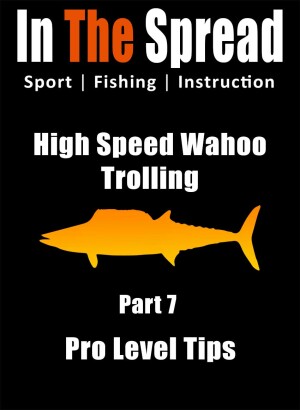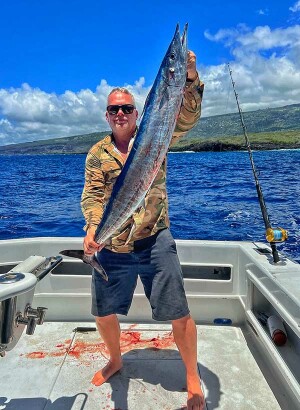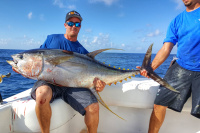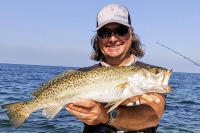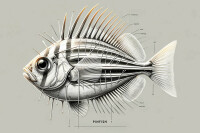High speed wahoo trolling demands precise rigging to handle these lightning-fast predators. Success in catching wahoo fish requires understanding how each component of your wahoo trolling rig works together. From selecting the right wahoo trolling lure to building a complete wahoo trolling setup, proper technique separates successful ono wahoo anglers from disappointed fishermen.

High Speed Wahoo Trolling Rig
Wahoo Fish

The Foundation: Choosing Your Mainline
Wire, Monofilament, or Braid?
When venturing into the exhilarating world of wahoo fishing, selecting the appropriate mainline for your rig is a decision that can significantly influence your success. This choice is often a topic of lively discussion among anglers, with three primary contenders: wire, monofilament, and braided lines. Each type comes with its unique set of advantages and challenges, making the decision highly dependent on personal preference, fishing conditions, and the specific nature of wahoo fishing.
- Durability and Resistance: Wire line's foremost advantage lies in its exceptional durability and resistance to the notoriously sharp teeth of the wahoo. This quality is crucial as wahoo are known for their ferocious strikes and can easily sever weaker lines.
- Handling and Care: Despite its strength, wire line demands a higher level of care in handling. It is less forgiving than other lines and can kink or break if not managed correctly. Anglers using wire need to be vigilant about the condition of their line and proficient in handling the unique challenges it presents.
- Application: Wire line is often favored in scenarios where the risk of line damage is high, especially in waters known for aggressive wahoo populations. Its resilience makes it a go-to choice for anglers prioritizing longevity and robustness in their setups.
- Flexibility and Strength: Monofilament lines strike a balance between flexibility and strength, making them a versatile choice for various fishing conditions. Their slight stretchability offers a buffer against the sudden jerks and pulls characteristic of wahoo strikes.
- Visibility and Buoyancy: These lines tend to be more visible in water, which can be a consideration in clear fishing conditions, especially when it comes to cut offs. They also have a measure of inherent buoyancy, affecting how lures and baits present in the water.
- Variety and Cost: Monofilament is available in a wide range of diameters and strengths, accommodating a broad spectrum of fishing styles and preferences. It's generally more affordable than other options, making it a popular choice for anglers who prefer a traditional approach or are mindful of budget.
- Low Maintenance and High Strength: Braided lines are celebrated for their low maintenance requirements and high strength-to-diameter ratio. This attribute allows for longer casting distances and deeper water fishing, which can be advantageous when targeting wahoo.
- Sensitivity and No Stretch: They offer high sensitivity, meaning anglers can feel even the slightest nibbles. The lack of stretch in braided lines provides a more direct connection to the lure, offering enhanced control during the fight with a fish.
- Abrasion Resistance and Use with Leaders: While braided lines are strong, they are not as resistant to abrasion as wire lines. Therefore, anglers often use a leader material, like fluorocarbon or wire, to provide additional protection against wahoo bites.
Terminal Tackle: The Key to Success
- Harmony in Components: The effectiveness of terminal tackle lies not just in the quality of individual components but in how well they work together. The balance and cohesion among the snap swivel, leader, hooks, and lures are what make a wahoo rig effective.
- Customization for Conditions: Terminal tackle should be tailored to the specific fishing conditions. This includes water clarity, depth, current, and even the prevalent baitfish in the area. An angler’s ability to adapt their terminal tackle to these conditions is a mark of expertise.
The Impact of Terminal Tackle on Trolling Experience
- Strike Detection and Hook Set: Good terminal tackle enhances the ability to detect strikes and set the hook effectively. This is particularly crucial in high-speed wahoo trolling, where reaction times are minimal.
- Durability and Longevity: High-quality terminal tackle can withstand the rigors of wahoo trolling, providing durability and longevity. This not only improves the chances of landing a wahoo but also offers better value over time, as the need for replacements is reduced.
- Confidence in Gear: Knowing that your terminal tackle is well-suited for the task at hand provides confidence. This confidence can be pivotal in making quick decisions during the heat of the moment, such as adjusting trolling speed or changing course.
Snap Swivels: The Unsung Heroes
- High-Speed Trolling Challenges: When trolling for wahoo, the speeds can often exceed 15 knots. At these speeds, the rotation of lures and the action of the water can cause significant line twisting. Without a reliable snap swivel, this twisting can weaken the line, leading to breaks and the potential loss of both fish and expensive tackle.
- Line Integrity: Maintaining the integrity of the line is crucial, and snap swivels play a central role in this. By allowing the line to untwist freely, they preserve the line's strength and ensure that the action of the lure is not hindered by resistance from the line.
Quality and Strength: Non-Negotiable Attributes
- Quality Matters: The quality of snap swivels cannot be compromised in wahoo fishing. Low-quality swivels may not withstand the immense forces exerted during a strike or the relentless pressure of high-speed trolling.
- Heavy-Duty Construction: Heavy-duty snap swivels are designed to handle the extreme conditions of wahoo trolling. They are typically made from high-grade materials that offer superior strength and corrosion resistance, essential for the harsh saltwater environment.
The Right Swivel for the Job
- Size and Weight Considerations: Choosing the right size and weight of the snap swivel is crucial. It must be strong enough to handle the force of a large wahoo but not so heavy that it hinders the natural movement of the lure. 400 lb snaps are a solid choice.
- Compatibility with Lures and Line: The swivel must also be compatible with both the line and the lure being used. This compatibility ensures that the swivel performs its function without negatively impacting the overall setup.
The Consequences of Swivel Failure
- Risk of Losing Fish: A failure in the snap swivel can be disastrous. It can lead to the loss of a potentially trophy-sized wahoo, as well as the loss of expensive lures and tackle.
- Damage to Equipment: In addition to losing fish, a failed snap swivel can cause tangling and damage to the fishing gear. This damage can be costly and time-consuming to repair, and it can end a fishing trip prematurely.
Investing in High-Quality Swivels
- Long-Term Benefits: While high-quality snap swivels may come at a higher initial cost, their long-term benefits justify the investment. They offer reliability, durability, and peace of mind, all of which are priceless in the pursuit of wahoo.
- Recommendations from Experts: Seasoned wahoo anglers often recommend specific brands and types of swivels that have proven effective in the field. Seeking advice from experienced fishermen can guide new anglers in making the right choice.
In conclusion, the significance of snap swivels in wahoo trolling cannot be overstated. They are essential components that safeguard against line twisting, one of the most common challenges in high-speed trolling. The selection of high-quality, heavy-duty snap swivels is a critical decision that can greatly influence the outcome of a wahoo fishing expedition. By investing in the best possible swivels, anglers can significantly enhance their chances of a successful and rewarding wahoo fishing experience.
Leads: The Weighty Decision
Leads are an integral part of any high-speed wahoo trolling rig, serving as a critical component in managing the depth and movement of lures. Their importance is magnified in the context of wahoo fishing, where the depth at which lures are presented can be the key to enticing these fast and aggressive predators. The choice of lead size and type is a nuanced decision, influenced by a variety of factors including sea conditions, the type of lure used, and the specific behaviors of wahoo.
- Depth Management: The primary function of a lead is to control the depth at which a lure swims. Wahoo are known to inhabit different water columns depending on factors like water temperature, light, and the presence of baitfish. Adjusting the lead weight allows anglers to target specific depths where wahoo are likely to be hunting.
- Lure Action: Beyond depth control, leads also influence the movement and action of the lure in the water. The right weight can enhance the lure's natural action, making it more enticing to wahoo. Conversely, an improperly weighted lure can hinder its effectiveness.
Size Matters: Matching Leads to Lures and Conditions
- Lighter Leads for Top Lures: For top lures, which are designed to operate near the surface, lighter leads in the 6-16 ounce range are typically sufficient. These leads provide enough weight to keep the lure submerged and maintain the desired action without dragging it too deep.
- Heavier Leads for Short Lures: Short lures, intended to run deeper, require heavier leads. These leads ensure that the lures maintain their depth in the water column, staying in the zone where wahoo are feeding. The exact weight needed can vary, but it's often significantly more than what is used for top lures.
Adapting to Sea Conditions
- Variable Conditions: The sea's conditions, such as currents and wave action, play a pivotal role in determining the appropriate lead weight. Strong currents and rough seas might necessitate heavier leads to maintain lure depth, while calmer conditions allow for lighter weights.
- Depth Variability: In different fishing locations, the depth at which wahoo are found can vary. Anglers must be prepared to adjust their lead weights accordingly to reach these varying depths effectively.
Innovative Practices: Using Cable on Leads
- Preventing Wahoo Bites: Some experienced wahoo anglers use cable on their leads as an innovative method to prevent wahoo from biting through the lead. This practice stems from the wahoo's notorious ability to sever fishing lines and leads with their sharp teeth.
- Durability and Longevity: Using cable can enhance the durability and lifespan of the leads, making them a more economical and reliable choice in the long run.
Selecting the Right Lead
- Material Considerations: The material of the lead can also impact its performance. Traditional lead weights are common, but there are also alternative materials available that offer different benefits, such as environmental friendliness or increased durability.
- Visibility and Stealth: Some anglers choose to paint their leads or select colors that blend with the ocean environment, reducing visibility and increasing the lure's stealth.
In summary, leads are a vital but often understated component in high-speed wahoo trolling rigs. Their role in controlling lure depth and movement is crucial in targeting wahoo effectively. The selection of lead size and type is a dynamic process, influenced by the type of lure, sea conditions, and specific fishing strategies. Advanced techniques like using cable on leads showcase the innovative approaches anglers adopt to outsmart the wily wahoo. Understanding and mastering the use of leads can significantly enhance an angler's success in the challenging and exhilarating sport of wahoo fishing.

The Shock Factor: Absorbing the Impact
In the dynamic and high-stakes world of wahoo fishing, the shock cord is an indispensable component of any effective rig. Its primary function is to absorb the immense force generated during a high-speed wahoo strike, a characteristic trait of these powerful and fast predators. Understanding the nuances of a shock cord's role, including its optimal length, strength, and material, is crucial for any angler seeking success in wahoo fishing.
- High-Speed Impact: Wahoo are renowned for their explosive strikes, often hitting the bait at speeds that can exceed 60 mph. This incredible force can be too much for a rigid setup to handle, leading to snapped lines or lost fish.
- Shock Absorption: The shock cord acts as a buffer, absorbing the initial impact of the strike. This absorption reduces the risk of line failure and increases the likelihood of a successful hook set.
Determining the Ideal Length and Strength
- Length Considerations: The recommended length of a shock cord in a wahoo rig ranges from 30 to 60 feet. The optimal length depends on factors like the type of fishing, the speed at which you're trolling, and the behavior of the wahoo in your specific fishing area.
- Strength Requirements: The strength of the shock cord is equally important. A general recommendation is around 150 lb test, but this can vary. The key is to balance strength with flexibility - too strong, and it won't absorb enough shock; too weak, and it risks breaking under the force of the strike.
Material Choices for Shock Cords
- Monofilament vs. Cable: Shock cords are commonly made from heavy monofilament or cable. Monofilament offers more stretch, which can be beneficial in absorbing shock. Cable, on the other hand, provides greater resistance to wahoo's sharp teeth but offers less shock absorption.
Connecting the Shock Cord
- Integration with the Rig: The shock cord is typically connected between the mainline and the leader. This placement ensures that the shock of the strike is absorbed before it reaches the more rigid parts of the rig.
- Securing the Connections: The connections on either end of the shock cord are critical. They must be robust and reliable, as a failure at these points can render the shock absorption ineffective. Techniques like crimping or specialized knots are often used to secure these connections.
Tactical Considerations
- Depth and Action Impact: The shock cord can also impact the depth at which the lure swims and its action in the water. Anglers need to consider this when setting up their rigs, ensuring that the shock cord complements the overall lure presentation.
- Variable Conditions: In different sea conditions, the behavior of the shock cord can change. For example, in rougher seas, a longer or more flexible shock cord might be beneficial to handle the increased movement and force.
To recap, the shock cord is a fundamental element of a wahoo fishing rig, designed to withstand the incredible forces involved in wahoo fishing. Its role in absorbing the shock of a high-speed strike is crucial in preventing gear failure and ensuring successful hooksets. The selection of the right shock cord – considering length, strength, and material – requires a thoughtful approach, balancing the need for durability against the necessity for shock absorption. Mastery of this component can significantly enhance an angler's ability to effectively target and catch the formidable wahoo.
Hook Line: The Critical Connection
The section of the rig extending from the shock cord to the hook is a crucial aspect of wahoo fishing, often sparking debate among seasoned anglers. This segment needs to withstand the tremendous strength and sharp teeth of the wahoo, making the choice of line material and hook type critical decisions that can greatly impact the success of a fishing trip.
- Challenges with Monofilament: While monofilament is a popular choice in various fishing scenarios due to its flexibility and stretch, it falls short in wahoo fishing. The primary concern is its susceptibility to being cut by the sharp teeth of a wahoo, especially during the intense strikes for which this species is known.
- Advantages of Wire or Cable: Wire or cable lines are generally recommended for this section of the rig. Their superior strength and resistance to cutting make them more suitable for handling the wahoo's bite. Wire lines offer durability and a certain level of flexibility, while cable lines provide even greater resistance to being severed.
- Considerations for Rigging: When using wire or cable, it's important to consider factors such as the diameter and flexibility of the material. The line should be heavy enough to withstand a wahoo's bite but not so rigid that it hampers the lure's action in the water.
Hook Selection: Single vs. Double Hook Rigs
- Single Hook Rigs: Single hooks are often used for their simplicity and effectiveness. They are easier to rig and can be less damaging to the fish, which is an important consideration for catch-and-release fishing. The key is to choose a hook that is strong enough to handle the wahoo's fight and sharp enough to ensure a solid hookset.
- Double Hook Rigs: Double hook rigs, on the other hand, offer the advantage of increased hooking potential. This can be particularly beneficial when targeting larger wahoo or when fishing in areas with high competition from other predators. However, they can be more complex to rig correctly and may increase the likelihood of snagging.
- Matching Hooks to Lure Size and Position: The choice between single and double hooks often depends on the size and type of lure being used. Larger lures, especially those in the short position (closer to the boat), may benefit from double hooks to maximize the chances of a successful hookset. Smaller, long-position lures might be better served with single hooks to maintain a natural presentation.
Tactical Considerations in Hook and Line Selection
- Lure Action and Presentation: The combination of line and hook should complement the lure's action and presentation. A poorly matched setup can hinder the lure's effectiveness, reducing the likelihood of attracting wahoo.
- Durability and Maintenance: Both wire and cable lines require regular inspection and maintenance, as they can suffer from wear and tear, especially after encounters with wahoo. Hooks should also be checked for sharpness and strength, as a dull or weakened hook can result in missed opportunities.
- Adaptability to Conditions: Experienced wahoo anglers often adjust their hook and line choices based on specific conditions, such as water clarity, current, and the behavior of the fish on a given day. This adaptability can make a significant difference in the success of a fishing trip.
In summary, the line and hook setup from the shock cord to the lure is a subject of considerable debate in wahoo fishing, with decisions heavily influenced by the unique challenges posed by this formidable species. The use of wire or cable lines offers the necessary strength and resistance to wahoo bites, while the choice between single and double hook rigs depends on factors such as lure size and fishing conditions. An angler's ability to carefully select and balance these components can greatly enhance the effectiveness of their wahoo fishing rig, leading to more successful and rewarding outings.

Lures and Skirts: The Final Flourish
The selection of lures and skirts in wahoo fishing is an arena where an angler's creativity and personal preferences truly come to the fore. This aspect of rigging offers an expansive range of choices, each with its unique appeal and effectiveness. Among the popular lure types, Ilanders, known for their skirted design and ability to mimic the movement of small fish, are a favorite for many. Jet heads, with their distinctively shaped heads that create a bubbly trail underwater, are another common choice, particularly effective in attracting the attention of wahoo. Bullet lures, characterized by their streamlined, torpedo-like shape, are valued for their ability to cut through the water with minimal resistance, making them ideal for high-speed trolling.
The variety doesn't end with the type of lure. The color and style of the skirts attached to these lures are equally significant and offer a vast palette for customization. Anglers often have strong preferences when it comes to skirt colors, with choices ranging from bright, attention-grabbing hues to more subdued tones that mimic the natural colors of baitfish. The decision is frequently influenced by factors such as water clarity, light conditions, and the angler's own experiences and success stories. Some prefer skirts that provide a stark contrast against the backdrop of the ocean, believing they are more effective in luring wahoo, while others opt for colors that blend seamlessly into the underwater environment.
The style of the skirt also plays a role in the lure's effectiveness. Some skirts are designed to flutter and wave in the water, creating a lifelike motion that can entice wahoo. Others are stiffer, designed to maintain their shape at high trolling speeds. The choice often comes down to the angler's observation and experience, as well as the specific conditions they are fishing in. It's not uncommon for seasoned wahoo fishermen to have a collection of different lures and skirts, ready to adapt their approach based on the day's fishing conditions and their personal intuition.
In the world of wahoo fishing, the lure and skirt combination is more than just a tool; it's a reflection of the angler's approach, experience, and even their personality. This variety and room for personalization make the preparation of the rig not just a crucial part of the fishing process, but also an enjoyable and creative endeavor.
Diving Deeper: Expert Opinions and Techniques
For anglers looking to delve deeper into the intricacies of high-speed wahoo trolling, our comprehensive series of wahoo fishing videos provides an invaluable resource. Available through the link below, these videos explores the myriad facets of wahoo rigs, offering a wealth of knowledge that caters to a broad spectrum of anglers, from novices to the highly experienced. In this detailed presentation, we bring together insights and tips from a diverse group of seasoned anglers, each sharing their unique perspectives and techniques honed through years of fishing.
The content of our wahoo videos is meticulously structured, beginning with the fundamental aspects of setting up a wahoo trolling rig. It guides viewers through the basics, such as choosing the right mainline, selecting appropriate terminal tackle, and understanding the dynamics of lure and skirt combinations. This foundational knowledge is crucial for those new to the sport, ensuring they start on the right foot.
As each video progresses, it delves into more sophisticated techniques and strategies. Viewers can learn about the nuances of adjusting rigs for varying sea conditions, the art of selecting and balancing leads for optimal lure depth and movement, and the critical decision-making involved in choosing between different types of shock cords, lines, and hooks. These videos also touches on the less tangible aspects of wahoo fishing, such as interpreting the behavior of the fish and adapting tactics accordingly.
One of our video series strengths lies in the presentation of diverse angling styles. By featuring a range of anglers, each with their own preferred methods and setups, these videos highlight the versatility and creativity inherent in wahoo trolling. This diversity not only broadens the viewer's understanding of the sport but also encourages them to experiment and develop their own unique approach to wahoo fishing.
Overall, the In The Spread wahoo videos stand as a comprehensive guide, rich in practical advice and expert insights. It's an essential tool for anyone eager to excel in the thrilling and rewarding challenge of high-speed wahoo trolling, offering valuable lessons that extend beyond the basics and delve into the finer points of this exciting sport.
The Final Take
In conclusion, high-speed wahoo trolling is a thrilling and demanding sport that requires not just skill but also a deep understanding of the right equipment and techniques. From choosing the right mainline to the intricacies of terminal tackle, every aspect plays a critical role in ensuring a successful catch. The beauty of wahoo fishing lies in the variety of approaches and preferences, making it a continually evolving and exciting sport. Whether you're a beginner or a seasoned angler, the world of high-speed wahoo trolling is an adventure waiting to be explored.
Seth Horne In The Spread, Chief Creator









